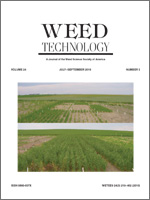Bispyribac-sodium effectively controls annual bluegrass in creeping bentgrass fairways but efficacy on putting greens may be affected by management differences and thus, application regimes may need to be modified for effective annual bluegrass control. To test this hypothesis, field experiments investigated various bispyribac-sodium application regimens for annual bluegrass control on creeping bentgrass putting greens. Bispyribac-sodium regimes totaling 148, 222, and 296 g ha−1 controlled annual bluegrass 81, 83, and 91%, respectively, over 2 yr. Pooled over herbicide rates, bispyribac-sodium applied two, three, and six times controlled annual bluegrass 78, 83, and 94%, respectively. The most effective bispyribac-sodium regime was 24.6 g ha−1 applied weekly, which controlled annual bluegrass 90% after 8 wk with acceptable levels of creeping bentgrass discoloration. After 8 wk, all regimes reduced turf quality as a result of voids in turf following annual bluegrass control; regimes with six applications reduced turf quality the most.
Nomenclature: Bispyribac-sodium; annual bluegrass, Poa annua L.; creeping bentgrass, Agrostis stolonifera L. ‘L-93’.





